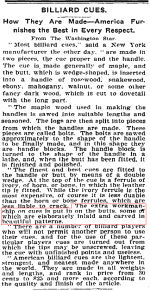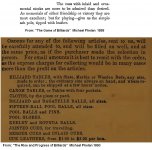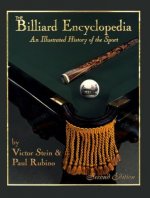You are using an out of date browser. It may not display this or other websites correctly.
You should upgrade or use an alternative browser.
You should upgrade or use an alternative browser.
How Cues Are Made - History and Evolution
- Thread starter Mr. Bond
- Start date
Very interesting. :thumbup2:
Thanks for posting.
Thanks for posting.
Yes it does.
Here is another great chunk of history on the development of the cue. (in the U.S.)
It even mentions a tidbit about cue cases as well.
Informative and quite sarcastic in a funny way. Good stuff Maynard
THE EVOLUTION OF THE INDISPENSABLE BILLIARD CUE.
What It Is Now Compared With Thirty Years Ago
There is another new "fad" on the market, and it will probably not surprise any one to learn that it is connected or associated with the billiard cue. Indeed, the various "devices, concoctions or alleged improvements" in cues during the past fifteen years would make the great masters of billiards, that is, prior to these innovations, or when billiard players resorted to the cue and not the press of this country, wonder if most professionals of today are not crazy...
....It is no very great stretch of the professional imagination to recall the time when even amateur experts could do very good work with a hickory or an ashen piece of wood. Later on, plain "French" cues were introduced, and when a man appeared with an ivory tip on his cue, it was generally conceded that he was either a great expert, a "crank" or "away off" if, indeed, not a combination of the three.
Jointed cues at such a period were of course unknown and unheard of, but they made their appearance; first, with that proverbial modesty of any new innovation, or without an ivory band, which always breaks when it should not, and never does when it should; or when the room-keeper wishes that such cues were in hades.
The next improvement (?) was the introduction of the brass screw, which is so ruinous to the other part of that fantastic weapon. After one joint or shaft to a cue became possible, there was of course no reason why two or three should not be made to fit the imagination of the experts' rod.
Any man who owns a private cue at the present day and has not at least two shafts for it is not, of course, worthy of being regarded as an "expert." These shafts, as a matter of course, greatly differ in construction when it comes to the point. One point is sufficiently large to make it possible to put a cue leather on it; while the point of the other is such as to strongly suggest a darning needle. And yet, the owners of these very cues never could understand why a local room-keeper, in his desperation to keep the leathers on, tacked them on, when glue or cement would not do the work!
The next improvement (?) in private cues was in cording the lower part of that weapon, to absorb, presumably or ostensibly, the perspiration of the expert's hand; but in reality to enhance the value of the cue.
After this fad we were introduced to the cue case, first made of canvas, but now made of leather, and so elaborately constructed that it generally takes the player fifteen or twenty minutes to pick out his favorite shaft before he is ready to commence hostilities on the billiard table. The corded shaft, however, is destined to become a thing of the past; just as the "hammered" and other fantastically constructed cues are, for a more recent or modern device.
The latest creation of the inventor's brain is the covering of the lower part of the cue with cork, probably to correspond with the imagination of its creator. It is certainly less a nuisance than the twine, which is always getting loose, and as it is not always convenient or possible for the room-keeper to have an expert present to re-cord the cue, there was always imminent danger that the owner might break one of his legs through accident. Should the room-keeper venture to repair the cue by gluing the cord together, that would, of course, be obnoxious to the sensitive imagination of the owner.
There is something to be said in favor of these fancy or fantastic cues. Jointed they never should be, as they frequently break just where both parts are put together: at the same time, it is a great convenience to have a jointed cue when a man cares to carry it around the world, as does Nicolini, and scores of other amateur experts. It is also a convenience to have two shafts to one cue; for when the leather comes off one, the other can take its place. But probably that which should most recommend these articles of merchandise is the fact that they give work to very many men who may have families to support, and during the past five years it has been a God-send to many a worthy and deserving man to procure work at almost anything.
On the whole, the modern fancy cue in the billiard room is not to be despised, even if it is a good deal of a nuisance. It sells well, and as such, for obvious reasons, should be encouraged; even if it is not better to play with now than the plain article of thirty or forty years ago.
Excerpt from: Sporting Life p.19 May 15 1897
courtesy la84.org
It even mentions a tidbit about cue cases as well.
Informative and quite sarcastic in a funny way. Good stuff Maynard
THE EVOLUTION OF THE INDISPENSABLE BILLIARD CUE.
What It Is Now Compared With Thirty Years Ago
There is another new "fad" on the market, and it will probably not surprise any one to learn that it is connected or associated with the billiard cue. Indeed, the various "devices, concoctions or alleged improvements" in cues during the past fifteen years would make the great masters of billiards, that is, prior to these innovations, or when billiard players resorted to the cue and not the press of this country, wonder if most professionals of today are not crazy...
....It is no very great stretch of the professional imagination to recall the time when even amateur experts could do very good work with a hickory or an ashen piece of wood. Later on, plain "French" cues were introduced, and when a man appeared with an ivory tip on his cue, it was generally conceded that he was either a great expert, a "crank" or "away off" if, indeed, not a combination of the three.
Jointed cues at such a period were of course unknown and unheard of, but they made their appearance; first, with that proverbial modesty of any new innovation, or without an ivory band, which always breaks when it should not, and never does when it should; or when the room-keeper wishes that such cues were in hades.
The next improvement (?) was the introduction of the brass screw, which is so ruinous to the other part of that fantastic weapon. After one joint or shaft to a cue became possible, there was of course no reason why two or three should not be made to fit the imagination of the experts' rod.
Any man who owns a private cue at the present day and has not at least two shafts for it is not, of course, worthy of being regarded as an "expert." These shafts, as a matter of course, greatly differ in construction when it comes to the point. One point is sufficiently large to make it possible to put a cue leather on it; while the point of the other is such as to strongly suggest a darning needle. And yet, the owners of these very cues never could understand why a local room-keeper, in his desperation to keep the leathers on, tacked them on, when glue or cement would not do the work!
The next improvement (?) in private cues was in cording the lower part of that weapon, to absorb, presumably or ostensibly, the perspiration of the expert's hand; but in reality to enhance the value of the cue.
After this fad we were introduced to the cue case, first made of canvas, but now made of leather, and so elaborately constructed that it generally takes the player fifteen or twenty minutes to pick out his favorite shaft before he is ready to commence hostilities on the billiard table. The corded shaft, however, is destined to become a thing of the past; just as the "hammered" and other fantastically constructed cues are, for a more recent or modern device.
The latest creation of the inventor's brain is the covering of the lower part of the cue with cork, probably to correspond with the imagination of its creator. It is certainly less a nuisance than the twine, which is always getting loose, and as it is not always convenient or possible for the room-keeper to have an expert present to re-cord the cue, there was always imminent danger that the owner might break one of his legs through accident. Should the room-keeper venture to repair the cue by gluing the cord together, that would, of course, be obnoxious to the sensitive imagination of the owner.
There is something to be said in favor of these fancy or fantastic cues. Jointed they never should be, as they frequently break just where both parts are put together: at the same time, it is a great convenience to have a jointed cue when a man cares to carry it around the world, as does Nicolini, and scores of other amateur experts. It is also a convenience to have two shafts to one cue; for when the leather comes off one, the other can take its place. But probably that which should most recommend these articles of merchandise is the fact that they give work to very many men who may have families to support, and during the past five years it has been a God-send to many a worthy and deserving man to procure work at almost anything.
On the whole, the modern fancy cue in the billiard room is not to be despised, even if it is a good deal of a nuisance. It sells well, and as such, for obvious reasons, should be encouraged; even if it is not better to play with now than the plain article of thirty or forty years ago.
Excerpt from: Sporting Life p.19 May 15 1897
courtesy la84.org
OMG! A screw-on ferrule. Or at least that's what it looks like.This is one of the earliest images of a cue case that I've run across...
If you have seen any older images feel free to post them here.
From an 1897 Oliver Briggs catalog
View attachment 297349
Muttonchops
Banned
makes you wonder if some of the cue makers today still know how to construct a full splice....
This begs the question Mr. Bond, what comes first for a quality cue maker today. Learning woodworking or learning pool? Kind of like the chicken vs egg thing.
This begs the question Mr. Bond, what comes first for a quality cue maker today. Learning woodworking or learning pool? Kind of like the chicken vs egg thing.
This is a tough question to answer simply because cue makers today come from such a wide variety of backgrounds (or previous work). Not all of them are former pool champions and not all of them began as craftsmen. It's also notable, that unlike the "old world", the u.s. has only a few remaining examples of families who have passed along a craft from father to son. The net result is a pool of craftsmen who don't all produce cues for the same reason; and their hearts are in different places.
One might be a designer simply looking for a medium. One might be a wood craftsman looking for a niche. One might be a player looking for the perfect hit. One may have started by being a repairman who just naturally progressed to working on whole cues...
In other words, you'd probably have to ask each one, to get an accurate answer.
Maybe one or more of them will chime in...
OMG! A screw-on ferrule. Or at least that's what it looks like.
I sold the antique que on the cover of the 1st edition of Billiard Encyclopedia to Paul Rubino, and it had a screw on ferrule. Actually the shaft tip shrewed into the bottom of the ferrule. In the image on this thread it looks like the ferrule screwed into the tip of the ferrule. The wood threads were worn and I remember some very old thread was wrapped around it, probably to give the ferrule a chance of staying on. My guess is the ferrule was a custom job by someone years ago.
I was living in Bamberg, Germany in the mid-late 80's, having just left the US Army. I was strolling through town and noticed an antique shop had several really old and intricately designed cues in the window. I bought that one, leaving the others behind (they weren't as nice). I sold the cue to Paul for $500, and I heard rumors the cue was sold to someone for $25K. I lost touch with Paul over the years, but I found one of the inlays that popped off, and I kept it in a plastic sandwich bag. Not sure what happened to it, doubtful I still have it. In any case whoever owns the cue today has a beautiful piece of art.
Attachments
Last edited:
This begs the question Mr. Bond, what comes first for a quality cue maker today. Learning woodworking or learning pool? Kind of like the chicken vs egg thing.
Imop there needs to be a larger quantity of the woodworking side than the being able to play at a high level. I surely believe that one must know something about playing pool to produce a good product, but without say copying another great builders techniques or apprenticing with one there would be no way for just a pure craftsmen to pump out a great cue.
There are so many things that go into the building of such a product....the pool/billiards cue being actually a percussion instrument at its most basic core. Everything a cuemaker does in the building of the instrument changes its "tuning" which is what players call the "hit".
Hit is also, as we all know very subjective. Tho, in general a good hitting cue is a good hitting cue.
In all over time a cue maker must learn much much more about the woodworking and instrumental side of making a cue than as to being a great pool player overall. How woods react, how they react with one another, how differing materials react and with one another along with the reaction with the types of wood used......so on and so forth. It is most definitely a science.
regards,
-Grey ghost
Imop there needs to be a larger quantity of the woodworking side than the being able to play at a high level. I surely believe that one must know something about playing pool to produce a good product, but without say copying another great builders techniques or apprenticing with one there would be no way for just a pure craftsmen to pump out a great cue.
There are so many things that go into the building of such a product....the pool/billiards cue being actually a percussion instrument at its most basic core. Everything a cuemaker does in the building of the instrument changes its "tuning" which is what players call the "hit".
Hit is also, as we all know very subjective. Tho, in general a good hitting cue is a good hitting cue.
In all over time a cue maker must learn much much more about the woodworking and instrumental side of making a cue than as to being a great pool player overall. How woods react, how they react with one another, how differing materials react and with one another along with the reaction with the types of wood used......so on and so forth. It is most definitely a science.
regards,
-Grey ghost
I agree, "craftsmanship" is not something that can be learned from reading a book. I have spent a great deal of time learning about cue construction, but I would never in a million years call myself a cuemaker. Wood is a dynamic material and there is no way to become proficient at working with it, other than working with it. (Just like any artist must first understand the materials and mediums they work with)
When I was a kid, this was not immediately apparent to me until I investigated a degree in architecture. I found that my first year of course work was learning about the properties of steel, concrete, glass, wood, etc...and I thought " what the hell does this have to do with designing buildings??"
One of my aha! Moments.




